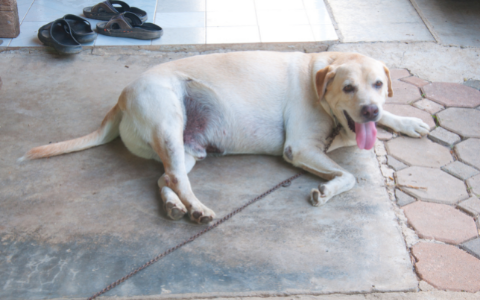No Products in the Cart
Is Your Dog Overweight?
Pet obesity is on the rise, and pet parents are often in denial that it's touching their pets. But you can be sure that it is a growing issue in the pet community, as facts and numbers in our article will unveil. Although typical, it is not a simple condition for veterinarians to discuss with pet parents. However, it is crucial to understand the long-term health implications for an overweight animal.
In 2022, more and more dogs and cats are becoming obese, and what should be an exception is now the rule. Unfortunately, this is a health disaster for veterinarians as being overweight, and obese leads to many debilitating diseases.

We will go over alarming numbers and the definition of obesity. We also share tips and tricks to monitor your pet's weight to ensure they stay happy and healthy for years to come!
Also Read: UC-II® Supplement for Dogs

Fig 1 - Photo of an obese dog
How many dogs are overweight in the USA?
In 2018, the Association for Pet Obesity Prevention survey estimated that 60% of cats and 56% of dogs in the United States were overweight or obese.
These numbers represent about 50 million dogs and 56 million cats in North America. Sadly these numbers are on the rise, as will probably show in the 2022 survey.
Among these figures, independent statistical company Statista estimated that 37% of dogs were overweight and 17% obese.

Fig 2 - 2018 Statista study on dog weight
Another shocking figure comes from Banfield hospitals which found that canine patients diagnosed as overweight or obese increased by 108.4% from 2011 to 2020.
How do you define obesity in dogs?
Veterinarians consider a dog overweight when their actual weight is 10% to 20% over their healthy weight. An obese dog weighs more than 20% over desired weight.
To help veterinary professionals have the same body evaluation tool, the World Small Animal Veterinary Association (WSAVA) created the Body Condition Score (BCS) with standard guidelines for what is a healthy weight. The Body Condition Score is a scale from 1 to 9 used by veterinarians to qualify a pet's weight. Although applicable to cats and dogs, we will often give examples involving dogs. So, just know it works for both specie.
For instance, from 6 in the BSC, your dog will start to be overweight. Each point over 5 represents 10% to 15% over ideal weight. So nine is between 50% and 75% weight over ideal.
You can sometimes find a simplified version of the BCS with a 1 to 5 scale where 3 is the standard weight.

Is my dog overweight or obese?
Your veterinarian is the best person to tell you if your dog has an average, healthy weight. With experience, a veterinarian quickly knows when your dog is overweight or not.
When assessing your dog's weight during a clinical exam, you will notice that veterinarians use a scale and their eyes and hands to tell what the Body Condition Score of your dog is.
To determine if your dog is overweight, the main question you want to ask yourself is: "Are the ribs easily palpable ?". If you can feel and count your dog's ribs without pressing hard, your dog's BCS is probably around 5. If you need to apply pressure to count them, your is perhaps over her or his healthy weight.
Another trick is to look at their waist from above: if your dog is at their ideal body weight, you will see a net cut off before the ribs, where the line will curve inwards.
Finally, if you want to be thorough, look at your dog's abdomen from the side: it should be tucked in and curve upwards naturally - no beer belly! ;)
In the extreme case where your dog is obese and close to a nine score, you'll start to see a coat of fat around his thoracic chest, and the ribs will be impossible to feel, much less count. Also, they won't have any tuck at their abdomen, and the waist will not be discernible from the rest of their body.
If your dog is overweight, you might want to check out our complete dedicated guide on how to help your dog loose weight. It includes quick, easy tips you can start applying today!
How do veterinarians know if my dog is overweight?
Here is the detailed version of the Body Condition Score that veterinarians have in mind and use combined with their experience:
Score 1 / 2 - Severely Underweight
- From afar, your dog appears bony.
- You can see the ribs, the spine, and the pelvis underneath the skin..
- You clearly see muscle mass loss.
Score 3 / 4 - Underweight
- You can easily see your dog's rib.
- Your dog doesn't appear to have any fat.
- Your dog still appears bony.
- The stomach is tucked high, and the waist is overly noticeable.
Score 5 - Ideal Weight
- You can't see your dog's ribs, but you can feel them because no excess fat covers them.
- Behind the ribs, the waist is visible from above.
- When you look at your dog from the profile, the abdomen curves upwards instead of straight back to the legs.
Score 6 / 7 - Overweight
- With the fat covering your dog's ribs, feeling them is tough.
- Fat deposits appear near the tailbone's base and in the back end area.
- The waist of your dog is either not visible or barely discernible.
- An abdominal tuck still may be present.
Score 8 / 9 - Severely Overweight
- Visible fat covers your dog's thorax (neck to abdomen), spine, and tail base. It's impossible to feel their ribs even by pressing hard.
- There's no waist tuck or abdominal tuck.
- You can see and feel the fat on your dog's neck and legs.
- The abdomen of your dog is distended and dangling.
What are the risks if my dog is overweight?
It's safe to say that any veterinarian you speak with will agree that an overweight dog is essentially a sick dog that will have lifelong debilitating conditions. You can believe from our experience that once a dog is heavy, it's hard to revert to a healthy weight, and the consequences can be catastrophic.
If you are the pet parent of an overweight bog, it will take discipline, consistency, and hard work to get them back in shape. But it will be worth it, and your pup will thank you in the long run!
A few examples of diseases your dog is at risk of developing as a result of overweight and obesity are:
- Diabetes
- Heart and kidney diseases and failure
- Severe mobility issues caused by early osteoarthritis and inflammation
Also Read: How Does Omega-3 Fatty Acids Help Dogs with Osteoarthritis?
If you want to learn more about the danger of obesity, you will find the ten diseases linked to obesity in our dedicated article.
We hope this article has helped you know more about obesity. After reading it, could you tell us what your dog's Body Condition Score is? Has your veterinarian already warned you about obesity risks?
If you want to share with the community, leave a comment below or email us at contact@petjope.com. It's all about helping beloved pets because of the Joy Of Pets.
FAQs
How do overweight dogs act?
Overweight dogs often seem sluggish, avoid play, and tire more easily. They may struggle with stairs, hesitate to jump, or show less interest in daily walks and routines. These behavioral changes are usually linked to discomfort or reduced stamina caused by excess weight.
Do overweight dogs sleep more?
Yes, many overweight dogs sleep more than usual. The extra weight can cause joint strain and fatigue, leading them to rest more frequently. If your dog is consistently inactive or lethargic, it could be a sign that their weight is affecting their energy levels. There might be other reasons so consult your veterinarian.
What is the best exercise for an overweight dog?
Gentle, consistent exercise is best. Start with short, daily leash walks and gradually build up time and distance. Swimming is also excellent for overweight dogs, as it supports their joints while providing a full-body workout. Every dog is different, so it’s important to match the routine to your dog’s age, condition, and mobility.
What problems do overweight dogs have?
Obesity increases the risk of arthritis, diabetes, heart issues, liver and digestive issues, respiratory problems, and reduced immune function. It also contributes to joint pain and limited mobility, especially in older dogs. Even moderate excess weight can have a big impact on a dog’s comfort and long-term health.
Does obesity shorten a dog's life?
















Leave a comment